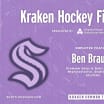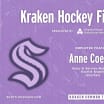These concepts have become more visible as the team has jelled. There are specific building blocks of this identity that can be monitored and measured.
Let's dig in.
The defensive corps of the Kraken is one built to be strong in terms of preventing opponents from scoring. According to Evolving-Hockey.com, Adam Larsson and Jamie Oleksiak lead all current Seattle players in terms of preventing shot quality against in five-on-five play (1.92 expected goals against per 60), and Jeremy Lauzon is not far behind at 1.99 expected goals against.
But fans can be assured Seattle D-men will also be active in creating offensive momentum themselves-based on analytics data from past seasons. For Hakstol, that translates to "working the play fast to get the puck back and then getting up the ice with it."
Makes sense, right? If you have the puck, your opponent doesn't. Once you get the puck, your priority is moving toward the end of the ice where your team can score.
We call this first step of getting the puck out of the zone, a "zone exit." Usually performed by defenders, a zone exit gets the puck across the blue line and moving towards your offensive zone.
It can be a pass, dump out or carry (when you skate with the puck on your stick). Every exit is either successful (you do get out of the defensive zone) or unsuccessful; and every exit is either "controlled" (your team keeps possession of the puck beyond the defensive zone) or "uncontrolled" (the puck just gets out of the zone and your team may or may not end up with it).
When it comes to how the Kraken want to play, it's all about successful, controlled exits that start an offensive push.
"We really harped on puck possession [in camp]," Vince Dunn said when asked about how the defense talks about their play. "We don't want to give the puck back to [opponents] and just dump it in and just let them start with the puck when we're line changing.
"I think being patient and holding on to the puck a lot more, that creates momentum for the forwards. More than anything, it's puck possession and puck placement."
And Dunn knows of what he speaks. According to data from the sport analytics company, Sportlogiq, last season in five-on-five play, Dunn averaged just under 9.5 successful exits per 60 minutes of play. Dennis Cholowski (9.46) and Jamie Oleksiak (9.36) performed at the same rate, while Haydn Fleury contributed 10.6 successful exits per 60.
Even more impressive is what happens after these players completed the exit itself. Sportlogiq tracks "exits with a successful play after" which means after the exit, there was a play with possession by the same team.
While the league average for defensemen last year was 78.1 percent, Dunn (79.6%), Fleury (81.6%), Cholowski (82.4%), Adam Larsson (86%), Mark Giordano (88%), and Will Borgen (91.7%) all surpassed that baseline. Across the entire corps, no Seattle defender was below 73-percent.
Dump outs will still happen, of course. The league average for how many exits are just sending the puck out of the defensive zone is 28.6 percent. So, seeing an uncontrolled puck fly out of the zone isn't cause for concern. It's worth noting all of the Seattle defensemen hovered close to or below the league average for dumpouts.
There's a lot of work that goes into scoring goals. Getting the puck out of your own zone is just the first piece of the puzzle. It's a good sign to see this Kraken blueline has the ability to exit the zone with control. That leads to more offensive opportunity and serves as one of the foundational blocks of how this team intends to play this season.



















